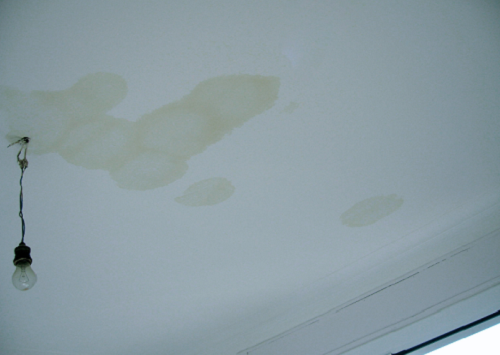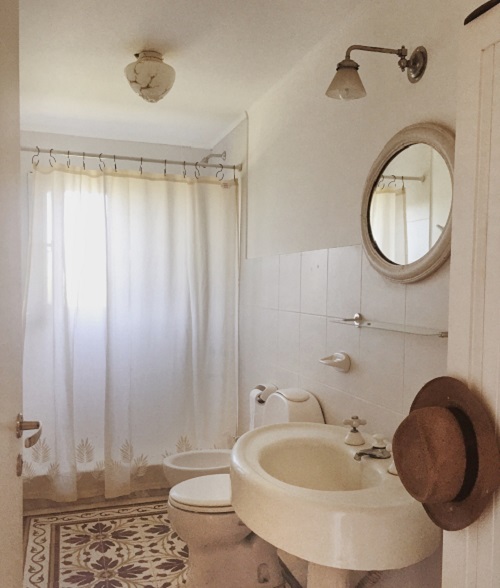While they are not pleasant to look at, yellow spots on bathroom ceiling are a common problem in most homes. They are not always easy to eliminate and have many different causes. We will look at some of the most common causes and solutions for yellow spots on bathroom ceilings, as well as some preventive measures to help you avoid them in the future.
What Causes Yellow Spots on Bathroom Ceiling?
Several factors can be responsible for yellow spots on bathroom ceilings. They include:
Leaking Water Pipes
Water from leaking pipes can be responsible for various types of damage, including yellow spots on your bathroom ceiling.
The water droplets are absorbed into the ceiling material, which causes it to break down and become discolored. If left for a long time, the ceiling will become moldy.
For pipes to leak, there has to be a problem with the plumbing. This could include a leaky faucet, burst pipes, or faulty joints. If you notice yellow spots on your bathroom ceiling, it’s important to check if there are any leaks in your home.
Painting Issues
You can’t underestimate the advantages of good bathroom paint. However, issues are bound to arise if you are not keen on your paint.
Painting issues can also be responsible for discolored bathroom ceilings.
There is more than one way that issues dealing with paint can cause your bathroom ceiling to have yellow patches.
Old painting: If the paint on your ceiling is old, it may start to flake off and cause yellow spots on your ceiling. If the old paint is not removed, it can cause your bathroom to look dirty and unappealing.
Poor quality of paint: If the paint you’re using to repaint your bathroom is poor quality, it may not cover well and can cause yellow patches on your ceiling. This is especially true of latex paints, which have a shorter shelf life than oil-based paints.
Insufficient dry time for the paint: Not giving your paint enough time to dry off can also cause yellow stains on your bathroom ceiling. The moisture will get trapped under it and cause it to discolor.
Smoking in the Bathroom
Ever seen the teeth of a consistent smoker? They’re yellow and stained. The same principle applies to your bathroom ceiling. If you smoke in the bathroom, the nicotine from the cigarette will get trapped under your coat of paint and cause it to discolor over time.
After nicotine and tar get absorbed by the paint, they are exposed to oxygen and moisture in the bathroom. This causes them to oxidize and turn yellow.
Poor Bathroom Ventilation
Bathrooms need to have proper ventilation for several reasons. The bathroom must have a steady supply of fresh air to help remove moisture from the room.
Without proper ventilation, moisture from hot steamy showers, and room sweat, will build up on surfaces such as your shower walls and ceiling, creating circular yellow condensation stains on the ceiling.
If left for a long time, the moisture will cause the growth of mold and mildew, which can spread quickly in the bathroom environment.
Aging Wall
An aging, worn-out wall can also cause yellow stains. As the wall ages, it loses its structural integrity. As a result, the surface of your walls can get damaged and broken, exposing raw materials to decomposing agents. This causes the raw materials to break down and oxidize, turning them yellow.
Poor house maintenance is almost always the cause for the walls to age rapidly and become worn out.
Hard Water (Minerals)
Water becomes hard when the mineral content is high. Homes with hard water are quite unfortunate as their bathroom ceilings are prone to yellow stains.
After the moisture from hard water vaporizes, the minerals are left behind on the ceiling and walls. This process is called deposition and causes yellow rust spots on bathroom ceiling.The more minerals there are, the harder the water will be.
Mold and Mildew
Mold and mildew are common culprits of yellowing your ceiling and walls since they always accompany most other causes. These microorganisms thrive in damp places that have poor ventilation, like bathrooms.
Causes of mold and mildew growth include:
- Poor ventilation, which can be caused by an outdated HVAC system or a dirty vent fan
- The presence of moisture and humidity in the air
- Lack of proper cleaning and maintenance
How Do I Get Rid of the Yellow Spots on My Ceiling?

If you’re looking to get rid of the brown spots on the ceiling bathroom, we’ve got some tips for you!
Repair Leaks and Faulty Joints
First, fix any leaks and faulty joints in your bathroom immediately so as not to incur huge costs later when the damage is severe. Leaks can cause excess moisture to build up in the walls and ceilings of your home. This can lead to mold and mildew growth, which can also cause yellow spots on your ceiling.
Get Rid of Mold and Mildew
Mold spores are pretty resilient—they can live on surfaces for a very long time. You can use bleach or disinfectant spray to clean off the mold from your ceiling. After cleaning off the mildew, wipe down with a towel to remove any remaining residue.
Make More or Repair Existing Ventilation
Bathrooms are typically very humid spaces which means that they can grow mold much faster than other parts of your home—especially if you have a poor ventilation system in place. It is also easier for yellow stains to develop on the ceiling if you do not have proper ventilation.
If you notice a lot of moisture on your bathroom ceiling, it might be time to install some ventilation or make more vents in the existing system.
Repaint the Bathroom Ceiling
Once all of these problems are fixed and repaired, you can repaint your bathroom ceiling to remove any remaining stains or discoloration caused by these issues!
When repainting your bathroom ceiling, you want to make sure that you use high-quality paint that can handle the bathroom environment. You also want to ensure that you properly prep the surface before painting!
Allow the paint to dry completely before using the bathroom again.
How to Prevent Yellow Spots on Bathroom Ceiling?
After getting rid of the yellow stains on your bathroom ceilings, you’ll want to prevent them from reappearing. There are a few different things you can do to prevent this problem from happening again!
Proper bathroom maintenance: Ensure proper maintenance of your bathroom’s pipes, joints, and fittings. This includes ensuring that the pipes are properly caulked and that any joints or connections are sealed tightly with pipe dope or another sealant. Proper maintenance helps with preventing leakages and water damage that can cause yellow stains on your bathroom ceiling.
Regular cleaning of the bathroom: Cleaning your bathroom regularly is an easy way to ensure that you’re preventing yellow stains on your bathroom ceiling. Use a mild bleach-free cleaner and wipe down all surfaces of the bathroom, including the walls, bathtub, and toilet.
Unclog any ventilation: Blocked bathroom vents are a common cause of yellow stains on your bathroom ceiling. You can easily avoid this by regularly cleaning and unclogging them. You should also make sure that any exhaust fans in the bathroom are working properly and are not blocked by dirt or debris.
Frequently Asked Questions
Q: Why do bathroom ceilings get stained?
A: There are many reasons why your bathroom ceiling might be stained. Yellow stains can appear on the ceiling because of water damage, mold and mildew growth, or aging paint or wall.
Q: Are the yellow stains on my bathroom ceiling dangerous?
A: The yellow stains on your bathroom ceiling are not dangerous, but they can be unsightly. If you are concerned about the stains, contact a professional who can help you determine the cause of the stain and how to remove it.
Q: Does the yellow color on my bathroom ceiling mean something is wrong with it?
A: The yellow stains on your bathroom ceiling could be a warning sign that there is an issue with your bathroom. Issues may include water leaks, poor ventilation, and mold or mildew growth.
Q: What if my stains on the bathroom ceiling are not yellow but another color?
A: You may also notice black or brown spots on ceiling in bathroom rather than yellow ones. If the stains are black, it means there is mold growing in your bathroom. Reddish brown spots on bathroom ceiling means there has been water damage, and you should contact a professional contractor right away.
Q: Why is mold growing on my bathroom ceiling?
A: Mold grows on your bathroom ceiling when there is moisture in the air, and it does not have a way to escape. This means something is preventing the moisture from leaving your bathroom. The most common cause of this problem is poor ventilation.
In Summary
Yellow condensation stains on ceiling are common in most bathrooms that are not well kept. Even though the stains are not dangerous, they can be embarrassing and unsightly.
If you have a stained bathroom ceiling, check thoroughly to determine the cause. You may be able to fix the problem yourself, or you may need to hire a professional.
Follow our guidelines to keep your bathroom ceiling stain-free, and you will be able to enjoy a beautiful bathroom experience.



